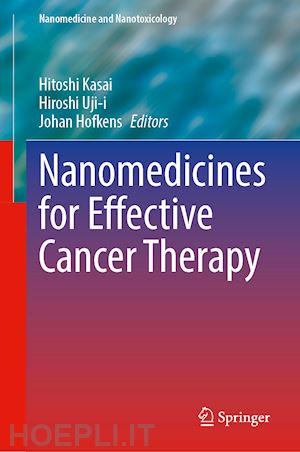

Questo prodotto usufruisce delle SPEDIZIONI GRATIS
selezionando l'opzione Corriere Veloce in fase di ordine.
Pagabile anche con Carta della cultura giovani e del merito, 18App Bonus Cultura e Carta del Docente
This book describes in detail the most up-to-date designs and fabrication techniques for nanomedicines toward effective cancer therapy, while especially emphasizing the biological interaction of nanomedicines at the cellular level, through comprehensive and visual cutting-edge technologies. Unlike other books on the general subject of medicine or drug delivery, this book provides readers the comprehensive information regarding what happens to the nanomedicine at the cell membrane surface, uptake mechanism, and what biochemical process it undergoes inside the cellular matrix. This full overview of the interaction between nanomedicines and cells also provides insights of how to design nanomedicines for effective cancer therapy.
Most recent designs of nano-prodrugs for Hydroxy camptothecin and Podophyllotoxin.- Pt(II)-diradical complex toward theranostics of cancer.- Design of novel self assembling based drugs.- Innovative gene/nucleic acid delivery system based on optimized intracellular trafficking steps.- Novel targeted therapeutic nano-sized, micro-sized particles as DDS for brain tumor.- Designs of non-toxic and multifunctional nanocarriers for cancer therapy.- Cancer microenvironment-targeted therapy by molecular blocks.- Functional polymer-based siRNA delivery carrier that recognizes site-specific biosignals.- Nanowire-based nanoscopy for intracellular PH sensing.- Bioanalytical nanoprobes and microfluidicis.- Improvement of Multi-photon Microscopy by Utilizing Novel Optical Technologies and Materials.- Intracellular imaging using quantum dots.- Intracellular investigation of prodrug nanoparticles.- Polymeric Nanoparticles for Highly Efficient Multifunctional Drug Delivery Systems.- From 2D to 3D Cancer Cell Models—The Enigmas of Drug Delivery Research.- Control of the Formation Process of Polypeptide Self-assemblies for Understanding Complex Biological Systems: From Nano-physiology to Artificial Cells.
Dr. Hitoshi Kasai received Ph.D. from Tohoku University in 1996 and has been a full professor at the same institute since 2016. During his Ph.D., he was majored in the creation of organic crystals with the main focus was on their electronics and photonics applications. Not long after, he realized the extreme potential of the technique in the creation of nanocrystals composed of pure anticancer drug molecules. The obtained nano-prodrugs showed greatly enhanced delivery efficacy while reducing the side effects which were usually caused by drug carrier materials in the conventional methods. With the great dedication for the last decade, his laboratory has become one of the first pioneers in the field and gradually strengthen the possibility of the carrier-free DDS. Until date, he has co-authored more than 300 publications including original papers, reviewing articles, book chapters, and patents.
Dr. Hiroshi Uji-I completed his Ph.D. at Tohoku University in 2002 and became a professor at the Research Institute for Electronic Science at Hokkaido University in 2015. He also serves as a research professor in the Department of Chemistry at the University of Leuven in Belgium. He has spent 16 years in Europe devoting to innovation of scientific researches collaborating with other internationally acclaimed scientists. He travels between Japan and Belgium frequently as a head of the research groups in both countries. His research interests lie in establishment of a methodology for investigation and manipulation of molecules, with a focus on nanomaterials and nanoscopy. He was awarded with European Research Council in 2011 and JST PRESTO research fellowship in 2010. To date, he has co-authored over 150 publications including original papers, reviewing articles, book chapters, and patents.
Dr. Johan Hofkens studied Chemistry at the KU Leuven (1984-1988), where he also obtained a Ph.D. degree in 1993, for his thesis on "Photoinducedintramolecular charge transfer in donor/acceptor substituted aromatics" (maxima cum laude). He is a professor at KU Leuven since 2002 and later promoted to the head of Subdivision Single Molecules in the same institute. He is a co-author of more than 700 articles in leading chemistry and multidisciplinary journals. His research interests are fast spectroscopy, single-molecule spectroscopy and fluorescence microscopy, and the development of new microscopy modes as well as applications of these microscopy modalities in nanobiological and nanomaterials research. Current research topics include optical mapping of DNA, luminescent noble metal clusters, perovskites, and nanofluidics in optical trapping, among others.











Il sito utilizza cookie ed altri strumenti di tracciamento che raccolgono informazioni dal dispositivo dell’utente. Oltre ai cookie tecnici ed analitici aggregati, strettamente necessari per il funzionamento di questo sito web, previo consenso dell’utente possono essere installati cookie di profilazione e marketing e cookie dei social media. Cliccando su “Accetto tutti i cookie” saranno attivate tutte le categorie di cookie. Per accettare solo deterninate categorie di cookie, cliccare invece su “Impostazioni cookie”. Chiudendo il banner o continuando a navigare saranno installati solo cookie tecnici. Per maggiori dettagli, consultare la Cookie Policy.